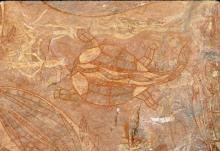Historical Context - Ancient History
Aboriginal and Torres Strait Islander peoples have a rich history in Australia. According to the most recent archaeological evidence, Aboriginal peoples have been living on this land for at least 65,000 years, confirming what Aboriginal people have always known, that they are the world’s oldest continuous living culture. Ancient History.
The following historical timeline has been compiled by the Australian Museum’s Indigenous Education Project Officer Renee Cawthorne. It focuses primarily on Aboriginal history in Australia prior to the arrival of Europeans.
63,000 BCE
The exact arrival in people in Australia is unknown. However, 10,000 artefacts including 1,500 stone tools, a grinding stone and ground ochres recently discovered in the Madjedbebe rock shelter (previously known as Malakunanja) in Mirrarr Country, in Northern Arnhem Land provide evidence that Aboriginal peoples have been living here for many thousands of years. Archeologists have dated these artefacts to be at least 65,000 years old.
The Madjedbebe site revealed that Aboriginal people made and used stone tools, ochre crayons and other pigments. This discovery includes the oldest known examples in the world of the use of the micaceous pigment. Microfossils and artefact residue found on grinding stones in the deepest and most dense part of the excavation reveal that Aboriginal people also collected and processed plant foods. Madjedbebe is the earliest evidence of seed grinding, pigment processing and use of edge-ground hatchets in the world.
47,000 BCE

Warratyi Rock Shelter
In 2016, archaeologist Giles Hamm and local Adnyamathanha Elder Clifford Coulthard discovered a rock shelter in the Northern Flinders Ranges. At Warratyi, they found 4,300 artefacts and 200 bone fragments from mammals and one reptile. The fossils, artefacts and ochre date the site to between 46,000 and 49,000 years ago. The Warratyi find also provides evidence that technologies such as bone needles, wooden handled stone tools and gypsum were used earlier than previously thought. The rock shelter also provides evidence of Aboriginal people living alongside megafauna, with the discovery of bones from the dripotodon and eggs from a giant bird dated to around 45,000 to 50,000 years ago.
43,000 BCE
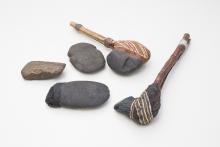
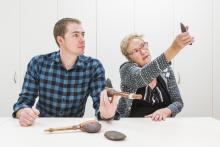
In 2016, Professor Sue O’Connor and her team found a fragment of a hafted stone axe in a large rock shelter in Winjana Gorge National Park. Dating of the charcoal sediments around the fragments revealed that they are between 45,000 and 49,000 years old making this the discovery of the world's oldest known axe.
41,000 BCE
Petroglyphs (rock engravings) in the Yunta and Olary districts of South Australia, provide evidence that the region has been inhabited for at least 43,000 years.
40,000 BCE
1,440 artefacts, including stone tools and spear tips, buried along the bank of the Jordan River provide evidence that Aboriginal people were living in this area north of Hobart at least 42,000 years ago.
38,000 BCE
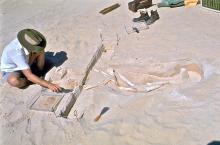
Anthropologist Dr Alan Thorne meticulously uncovering the remains of Mungo Man in February 1974
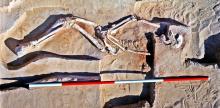
The 40,000-year-old remains of Mungo Man were discovered in 1974 on the southern sector of the eroding Lake Mungo shoreline.
In 1968, geologist Jim Bowler uncovered the partial remains of Lady Mungo in a dry lake bed in NSW. A few years later, in 1974, the discovery of the complete skeleton of Mungo Man just 300 metres from Lady Mungo revolutionised our understanding of the antiquity of Aboriginal civilization in Australia. After many decades of attempts to accurately date the remains, in 2003 both Lady Mungo and Mungo man were dated to 40,000 years old. Lady Mungo and Mungo Man are some of the oldest remains of modern humans ever discovered outside of Africa. Lady Mungo is the oldest known cremation in the world. Mungo Man is the world's oldest example of using ochre in a burial ritual.
33,000 BCE
Limestone deposits used to date cave paintings in Warreen Cave in the Maxwell Valley in southwest Tasmania demonstrate that people were living in the area 35,000 years ago.
29,000 BCE
Archaeological evidence from charcoal found in a hearth suggests that Aboriginal people were living at the Keilor site (now called Murrup Tamboore) near Melbourne around 31,000 years ago.
28,000 BCE
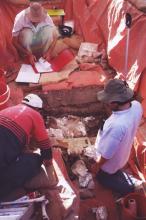
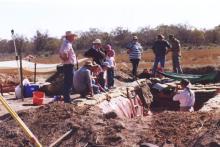
Fragments of grinding stones dating back 30,000 years have been found at the archaeological site at Cuddie Springs in western NSW. The excavation revealed the bones of large, now extinct animals and other animals that are still alive today. Stone artefacts dating from between 30,000 and 36,000 years ago have also been found. This is only one of two sites in Australia that contains such clear and complex evidence of the coexistence of mega fauna with humans.
20,000 BCE
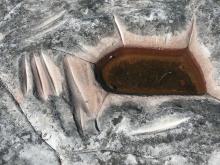
Grinding grooves (rock engravings) of bird and kangaroo tracks have been found at King Tablelands in the Blue Mountains. Excavation of this shelter revealed that Aboriginal people were living there 22,000 years ago. King Tablelands is the the oldest dated Aboriginal site in the Blue Mountains and is listed as a heritage site.
18,000 BCE
Aboriginal people are well established throughout coastal and mainland Australia and Tasmania.
18,000 BCE
Flaxed stone artefacts found near the Kutikina Cave in the Maxwell River Valley suggest that the area was occupied by Tasmanian Aboriginal people at the height of the last ice age, 20,000 years ago. At this time, some 10% of Tasmania was covered by glacial ice.
14,000 BCE
Sea levels begin to rise as ice caps melt. Inland lakes such as Lake Mungo dry up.
14,000 BCE
Wasp nests surrounding rock art in the Mitchell Plateau date these paintings in the Kimberley region of Western Australia to at least 16,000 years ago.
11,000 BCE
Land bridges between mainland Australia and Tasmania are flooded. This results in Tasmanian Aboriginal people being isolated for the next 12,000 to 13,000 years.
11,000 BCE
In a cave on Salisbury Island, 60km off the coast of Esperence in Western Australia, researchers from Applied Archaeology Australia discovered stone tools that are at least 13,000 years old. It is believed that the island would have risen by 80 to 100 metres above sea level during the Pleistocene Era and researchers believe that this cave may have been used as a shelter during the height of the last ice age.
8,000 BCE
Present day Australian climate established.
7,000 BCE
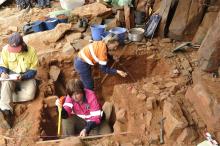
On Rosemary Island in the Dampier Archipelago, researchers from the University of Western Australia found evidence of stone houses dating back 9,000 years. This makes them the oldest known houses in Australia. Researchers also found shell middens and a grinding stone in the house.
7,000 BCE
Three complete boomerangs made of drooping sheoak (Casuarina strict) and a number of other tools were found at the bottom of Wyrie Swamp. It is believed that the ancient swamp helped to preserve them. The Wyrie boomerangs have been dated to be at least 9,000 years ago, making them Australia's oldest boomerangs. However, rock paintings from the Kimberley region of Western Australia suggest that boomerangs were in use from at least 20,000 years ago.
6,000 BCE
The Torres Strait Islands are formed when the land bridge between Australia and New Guinea is flooded by rising seas.
4,000 BCE
Archaeologists have found evidence of Aboriginal occupation in the Furneaux Group of Islands that can be dated back 4,000 to 6,000 years ago The Furneaux Group is made up of more than 50 islands of the northeast coast of Tasmania, including Flinders Island, Cape Barren Island and Clarke Island.
4,000 BCE
The 'shape' of Australia's coastline is defined by present sea level.
3,000 BCE
The dingo arrives in Australia.
3,000 BCE
There is evidence of Aboriginal occupation sites and tool making along the Nepean River near Penrith Lakes in NSW. Stone flakes have been dated to be at least 5,000 years old.
1588 CE
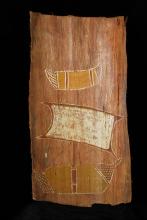
Dutch documents record the journey of Macassan trepangers to Northern Australia. From 1588, Macassan praus (a type of sailing boat) sail to the northeastern coast of the Northern Territory. They trade sea cucumber (trepan) and introduce glass to the local Aboriginal people, who adapt it to make spear tips. Trade between the Macassan and Aboriginal people in this area continued until 1906.
1600 CE
Bone tool deposits at Otway Peninsula in Victoria suggest Aboriginal people were working with animal skins 400 years ago.
1606 CE
Dutchman Jan Carstenz described several armed encounters with Aboriginal people on the northern coast of Australia. Shots were fired and an Aboriginal man was hit.
1697 CE
Englishman William Dampier visited the west coast of Australia.
1768 CE
Anticipating that Captain Cook would discover the great southern land, he was issued with special instructions to "with the consent of the natives take possession of convenient situations in the name of the King... or if you find the land uninhabited Take Possession for His Majesty".
This historical timeline was compiled using the following sources:
- Artefact Heritage, 'Nepean River Green Bridge at Penrith Aboriginal Heritage Assessment' Report to RMS, September 2012. At http://www.rms.nsw.gov.au/documents/projects/sydney-west/nepean-river-green-bridge/nepean-green-bridge-ref-appendix-c.pdf
- Robert G. Bednarik, 'Australian Rock Art of the Pleistocene' (2010) 27: 1 Rock Art Research 89-113.
- Lester Bostock, 1990,The Greater Perspective,Special Broadcasting Service
- Kevin Butler, K. Cameron and B. Percival,The Myth of Terra Nullius, Invasion and Resistance - the early years (Board of Studies, 1995).
- Dani Cooper, 'World' oldest known ground-edge stone axe fragments found in Western Australia' ABC Science (online), 11 May 2016. At http://www.abc.net.au/news/science/2016-05-11/worlds-oldest-known-ground-edge-stone-axe-fragments-found/7401728
- Andrew Darby, 'Highway threatens ancient Aboriginal site' The Sydney Morning Herald (online). 11 March 2010. At http://www.smh.com.au/national/highway-threatens-ancient-aboriginal-site-20100310-pzaf.html
- Directorate of Special Programs, Aboriginal Australia, a Preliminary Chronology (NSW Department of Education, 1982).
- Flinders Council, 'Tasmanian Aboriginal History in the Furneaux Region'. At https://www.flinders.tas.gov.au/aboriginal-history
- Leigh Dayton, 'How did the dingo get to Australia' Science (online), 4 April 2016. At http://www.sciencemag.org/news/2016/04/how-did-dingo-get-australia
- Bryce Fraser (ed) 1983,The Macquarie Book of Events, Weldon,
- D Horton (ed),Encyclopaedia of Aboriginal Australia (Aboriginal Studies Press, 1994).
- Bill Jonas and Marcia Langton, The Little Red, Yellow and Black (and Green and Blue and White) Book (AIATSIS,1994).
- News Junkie Post, '40,000 Year Old Australian Archaeology Site Reignites Debate On Origins' News Junkie Post (online) 12 March 2010. At http://newsjunkiepost.com/2010/03/12/40000-year-old-australian-archaeology-site-reignites-debate-on-origins/
- M. F. Nobbs, 'Dating of Aboriginal Rock Engravings in Olary Province, South Australia' (1992) 30: 2 Journal of the Anthropological Society of South Australia 140-148.
- Margaret Nobbs and Ronald Dorn, 'New surface exposure ages for petroglyphs from the Olary Province, South Australia' (1993) 28: 1 Archaeology in Oceania 18-39.
- Erin Parke, 'Artefacts found in Pilbara cave show Aboriginal life in northern WA dates back 50,000 years' ABC News (online), 19 May 2017. At http://www.abc.net.au/news/2017-05-19/cave-shows-aboriginal-llife-50000-years/8541302
- Mischa Vickas, 'On this day: Mungo Man fossil found' Australian Geographic (online), 26 February 2013. At http://www.australiangeographic.com.au/blogs/on-this-day/2013/02/on-this-day-mungo-man-fossil-found
- Naaman Zhou, 'Earliest evidence of Aboriginal occupation of Australian coast discovered' The Guardian (online) 19 May 2017. At https://www.theguardian.com/australia-news/2017/may/19/indigenous-australian-life-cave-wa-50000-years

